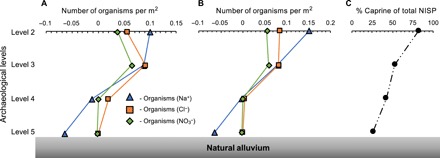Fig. 6. Model-predicted densities (organisms per square meter) of organisms required to produce urine-related [Na+], [Cl−], and [NO3−] found at Aşıklı Höyük, averaged across specific time intervals (levels 5 to 2).

(A) Assuming a constant sedimentation rate over the entire period of occupation and (B) using variable sedimentation rates based on carbon-14–dated level boundaries (8). Densities of ≤0 indicate that conservative estimates of other inherited, anthropogenic, and postdepositional sources of soluble salts account for total [Na+], [Cl−], and [NO3−] observed in the refuse. (C) Relative abundance [percentage of the total number of identified skeletal specimens (NISP)] of caprines in the vertebrate faunal assemblages averaged by level [updated from (7) from Aşıklı Höyük].
